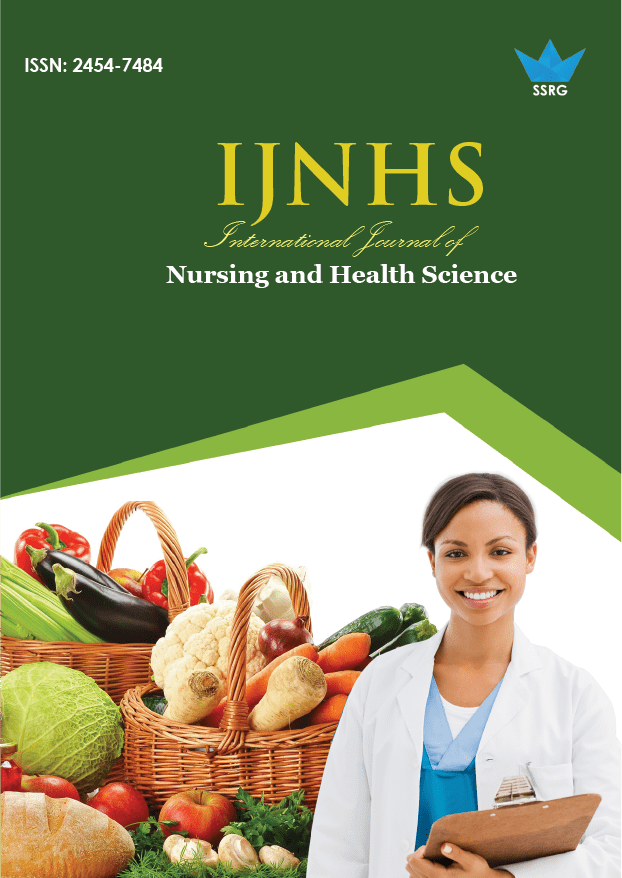Depression, Anxiety, And Stress Among The Postnatal Mothers of Low Birth Weight Babies Delivered At Tertiary Care Hospital of Belagavi, North Karnataka – A Hospital-Based Cross-Sectional Study

| International Journal of Nursing and Health Science |
| © 2020 by SSRG - IJNHS Journal |
| Volume 6 Issue 2 |
| Year of Publication : 2020 |
| Authors : Bhat AV, Pinto N, Kosumeri N |
How to Cite?
Bhat AV, Pinto N, Kosumeri N, "Depression, Anxiety, And Stress Among The Postnatal Mothers of Low Birth Weight Babies Delivered At Tertiary Care Hospital of Belagavi, North Karnataka – A Hospital-Based Cross-Sectional Study," SSRG International Journal of Nursing and Health Science, vol. 6, no. 2, pp. 6-8, 2020. Crossref, https://doi.org/10.14445/24547484/IJNHS-V6I2P102
Abstract:
The WHO estimates that, globally, the incidence of LBW is 15.5%, which means that about 20.6 million such infants are born each year, 96.5% of them in developing countries. Many studies reported about depression but very little is known about stress and anxiety which the postnatal mother go through when her new-born is born low birth and admitted in
NICU. Objectives: To assess the level of Depression, Anxiety, and Stress among the postnatal mothers of low birth weight babies. Materials and methods: A descriptive research design was used for this study. Postnatal mothers with low birth weight babies were the samples. The sample size was limited to 200 postnatal women. The setting for the data collection was maternity wards of tertiary care hospitals. Data were collected by using the DASS scale. Results: Results revealed that a maximum (51%) had moderate depression, 48% had severe anxiety, and 29% had mild stress levels. A positive correlation was found between Depression and Anxiety (0.61). Education level, occupation, and gestational age at delivery are associated with depression, age, education level, income, gestational age, and weight of the baby are associated with anxiety, and age, education level, gestational age, and weight of the baby are associated with stress. Conclusion: The study concluded that apart from depression, stress and anxiety are also a point of concern among the mothers who delivered low birth weight babies. There is a need to find the measures to answer these problems.
Keywords:
Stress, Anxiety, depression, low birth weight, NICU
References:
[1] WHO. Guidelines on Optimal Feeding of Low Birth Weight Infants in Low and Middle-Income Countries. Geneva: WHO, 2011
[2] UNICEF/WHO. Low Birth Weight, Country, Regional and Global Estimates, Geneva: UNICEF/WHO, (2006).
[3] Vismara L, Rolle L, Agostini F, Sechi C, Fenaroli V, Molgora S, et al., Postnatal stress, anxiety and depression outcomes in mothers; A 3 to 6 months postpartum follow up study. Front Psychol, 7 (2016) 938
[4] Crist, Nancy Gilbert, Women’s Perceptions of Postpartum Stress: A Narrative Analysis, (2010). Graduate Theses and Dissertations. https://scholarcommons.usf.edu/etd/3560
[5] Rollè, L., Prino, L. E., Sechi, C., Vismara, L., Neri, E., Polizzi, C., Brustia, P., Parenting Stress, Mental Health, Dyadic Adjustment: A Structural Equation Model, Frontiers in psychology, 8 (2017) 839. doi:10.3389/fpsyg.2017.00839
[6] Agbaje et al., Depressive and anxiety symptoms and associated factors among postnatal women in Enugu-North Senatorial District, southeast Nigeria: a cross-sectional study Archives of Public Health; 77 (2019) 1 https://doi.org/10.1186/s13690-018-0329-6
[7] Kettunen, P., Koistinen, E., & Hintikka, J., Is postpartum depression a homogenous disorder: time of onset, severity, symptoms, and hopelessness in relation to the course of depression; (2014). BMC pregnancy and childbirth, 14, 402? doi:10.1186/s12884-014-0402-2
[8] Osnes O S et al., Insomnia late in pregnancy is associated with perinatal anxiety: A longitudinal cohort study, Journal of Affective Disorders; 248 (2019) 155-56.
[9] Segre, L. S., McCabe, J. E., Chuffo Siewert, R., & O'Hara, M. W., Depression and anxiety symptoms in mothers of newborns hospitalized on the neonatal intensive care unit, Nursing Research, 63(5) (2014) 320–332. doi:10.1097/NNR.0000000000000039

 10.14445/24547484/IJNHS-V6I2P102
10.14445/24547484/IJNHS-V6I2P102